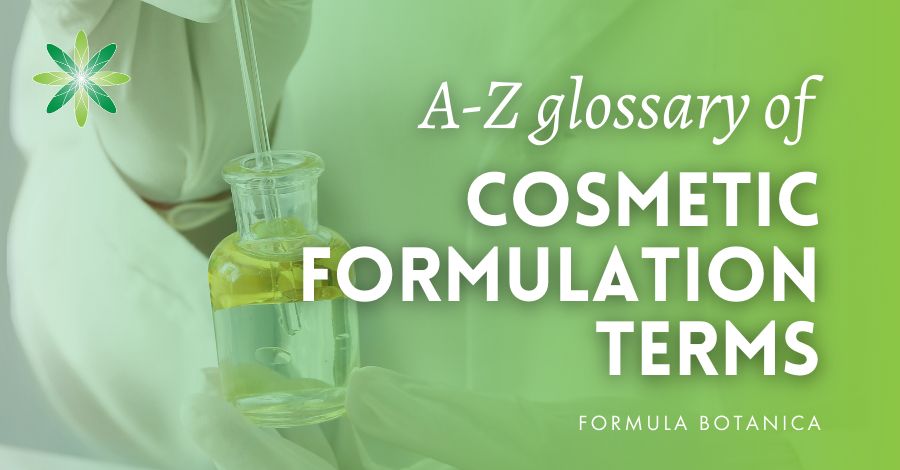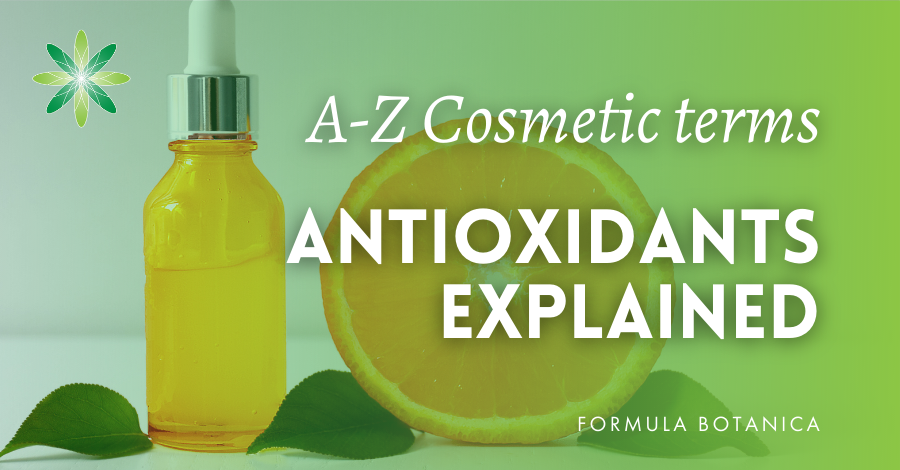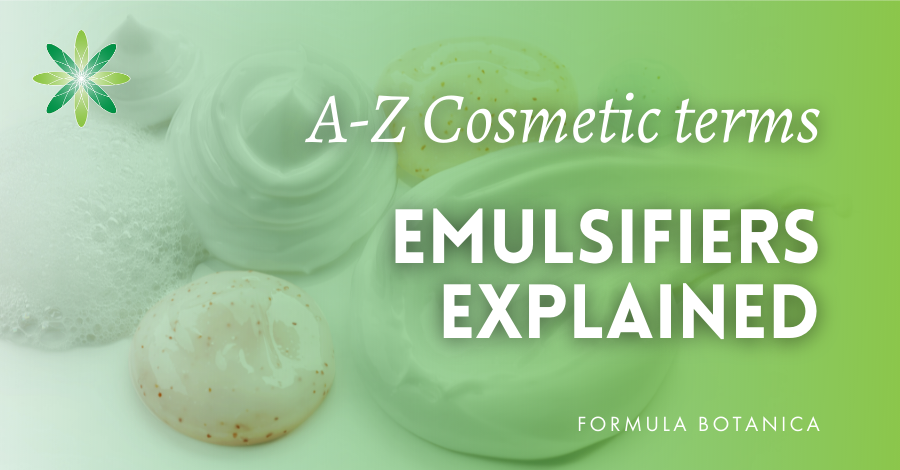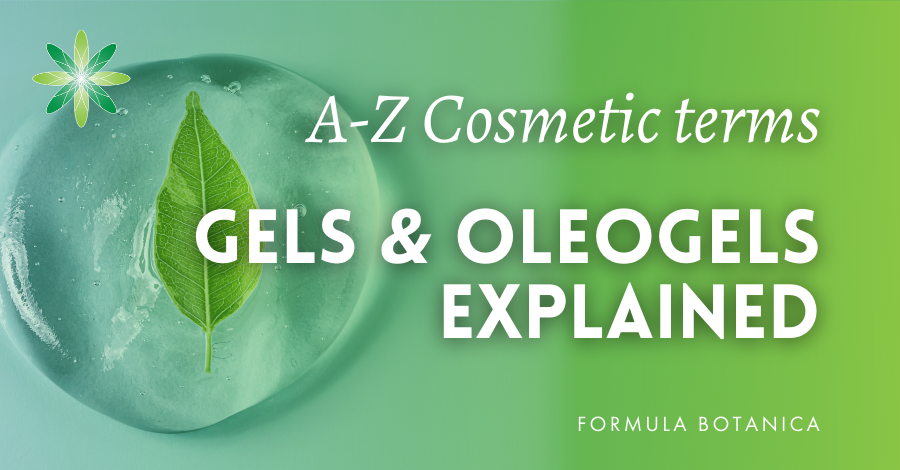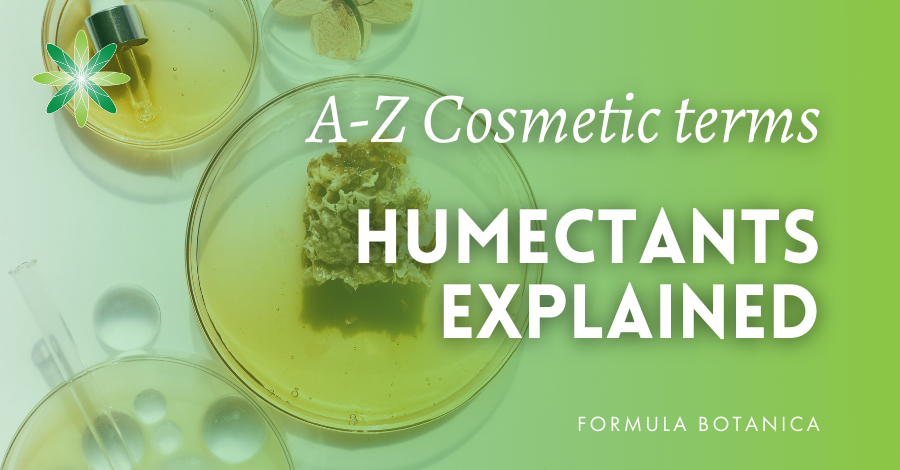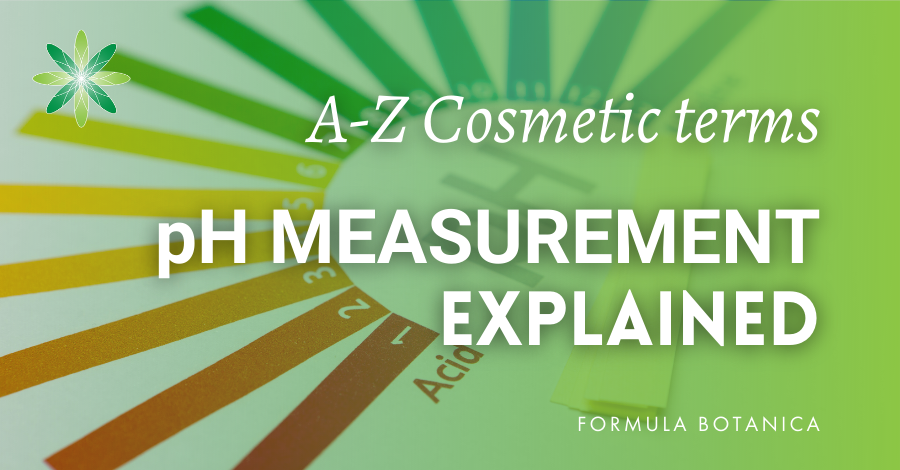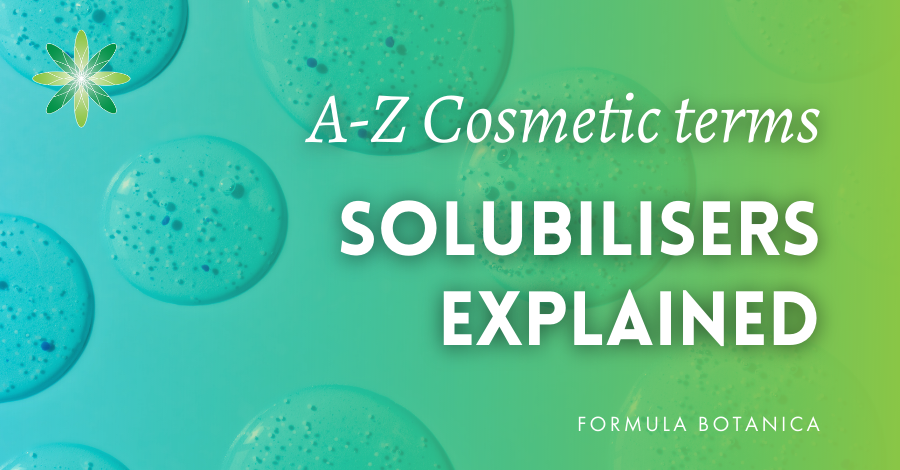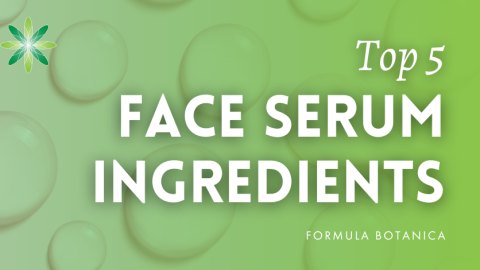Every industry has its own insider jargon and specialist terms, and cosmetic science is no different. The world of cosmetic formulation terms can be overwhelming especially if you are just starting out.
We often field questions in our school’s online classroom about the difference between solubilisers and surfactants and when to use them. Similarly, the difference between antioxidants and preservatives is another grey area that crops up frequently.
Not only do cosmetic formulators need to know what function a certain category of ingredients performs, but they also need to understand when and how to use it, as well as how it interacts with and affects other ingredients.
There is a lot to take in when learning cosmetic formulation. For this reason, we have compiled this glossary of the most common cosmetic terms. We link to other articles on our site that provide more comprehensive guides, example formulations and other resources that help demonstrate when, where and how to use certain ingredients.
We will be adding to this glossary over time, but to start with we have focused on cosmetic formulation terms that we know from experience our students ask about the most and need to understand early on in their studies with us. Armed with this reference, you can formulate with confidence.
Do you know your surfactants from your solubilisers? @FormulaBotanica demystifies these and more ingredients in its A-Z of key cosmetic formulation terms. #naturalformulation #cosmeticformulation #naturalskincare Share on X
View this post on Instagram
Click the letters to drop to the glossary listing (black letters are links).
A B C D E F G H I J K L M O P Q R S T U V W X Y Z
Frequently-used cosmetic formulation terms explained
Anhydrous
Derived from Greek, anhydrous means without water or no water. When referring to cosmetic formulations, anhydrous indicates a product or process devoid of water. Anhydrous cosmetics include products like lip balms, body butters and face oils which are formulated using lipids (fats) from plant-based butters, waxes and oils only.
Anhydrous formulations are popular first products to make when learning to formulate as having no water, they generally do not need preservatives. They can be easy and fun to formulate yet impart many skincare benefits and are product types loved by all age groups.
Antioxidant
Antioxidants reduce the oxidisation of cosmetic products, helping to retain their stability and extend their shelf life. They are added also as active ingredients in formulations to help mitigate the effects of oxidative stress commonly caused by the skin’s exposure to external factors such as pollution, cigarette smoke and UV light. Oxidative stress can accelerate the ageing process and cause the formation of wrinkles, hyperpigmentation, dryness, and loss of skin tone.
Common antioxidants included in cosmetic formulations include vitamin E, vitamin C, and coenzyme Q10, and plant-based antioxidants such as polyphenols, flavonoids, carotenoids and terpenes. The topical application of antioxidants helps boost our skin’s natural antioxidant protection. It is important to note that antioxidants are not classed as cosmetic preservatives. Although they contribute to a cosmetic product’s stability and longevity, they do not protect it from degradation from mould, yeast and bacteria. We explain why antioxidants are not preservatives in 10 myths of natural formulation to debunk.
See also our comprehensive article:
Chelator
The plain definition of a chelator or chelating agent is an ingredient that binds to metal ions. Chelating agents are added to cosmetic formulations to help render active metal ions inert and thereby help stabilise a product and reduce its potential to oxidise. Metal impurities may come from water in a cosmetic formulation and from other natural, water-containing ingredients, as well as in minute parts from metal containers and equipment used during formulation and for storing the product.
Chelators are common in almost all types of cosmetic formulations and added to help reduce the potential for their rancidity, discoloration and degradation and to help boost the shelf life and performance of ingredients like vitamins and essential oils. Typical chelators in natural formulation are: phytic acid and its salt sodium phytate; gluconic acid and its derivatives sodium gluconate and gluconolactone; and citric acid, which is a weak chelator.
Emulsifier
Emulsifiers bind together water (hydrophilic) and oil (lipophilic) ingredients to create homogenous blends called emulsions. Water and oil do not mix so emulsifiers are needed to create cosmetic creams, lotions and serums that contain both water- and oil-based ingredients in smooth stable blends. There are many emulsifiers to choose from to use in organic skincare and haircare formulations. They can be oil-in-water (O/W) or water-in-oil (W/O) emulsifiers and designed to be used in hot-processed or cold-processed emulsion making. Your choice of emulsifier is not always easy and will depend also on the skin-feel you wish to achieve as well as the type of end product you wish to create. You might also wish to use palm-free emulsifiers to be in line with a green formulation ethos. Emulsion making is one of the more complex formulation techniques and takes practice. See our comprehensive articles on emulsifiers:
Everything you wanted to know about natural emulsifiers
17 points to consider before choosing a natural emulsifier
The difference between hot, cold, and hot-cold process emulsions
Fatty alcohols / fatty acids
Fatty acids are oily molecules that are the main components of triglycerides, phospholipids, and other lipids (see ‘lipids’ below). They are composed of a hydrocarbon chain linked to a carboxylic group (the acidic part) at the end of the molecule. The hydrocarbons are what make these molecules hydrophobic and lipophilic. Vegetable oils and butters are mainly composed of triglycerides, which are esters of glycerine and fatty acids. They also contain small amounts (usually less than 2%) of fatty acids that are not linked to a glycerine molecule, called free fatty acids.
Fatty alcohols are similar to fatty acids, but instead of a carboxyl group at the end of the carbon chain, they have an alcohol group. They can be present in natural sources such as waxes or be produced from vegetable oils. Depending on the size and branches of their carbon chain, they can be oily liquids or waxy solids. Usually, they are used in cosmetic products as emollients able to thicken emulsions or anhydrous products. Although fatty alcohols are often mistaken for ethanol (ethyl alcohol), they have very different properties and are not drying to the skin.
Formula / formulation
A cosmetic formula is the percentage, or weight-based list of ingredients required to formulate a product, along with the method and techniques of production. It is in effect a recipe and expressed in mathematical terms. A formulation (noun) is the result of the process or act of formulating (verb). A cosmetic formulation is therefore the end product created (usually) by using a mathematical formula and through the process of formulating. On this site, we offer many cosmetic formulations with their weight-based formulas for you to try formulating.
Gels
Gels are quite thick and viscous cosmetic products when in their container but thin or seem to melt into the skin and into hair when dispensed and applied. They are generally translucent or opaque but can be coloured with colorants or naturally by other ingredients. They are used to create numerous types of personal care products. Some of the most common are shower gels, hair styling gels, gel-to-foam cleansers, exfoliants and also some moisturisers can have gel-like consistency before application. What is common to all gels is their need for a gelling or thickening agent in the form of gums and/or sucrose gelling agents such as the polysaccharide ingredient carrageenan which is extracted from seaweed and proprietary products like Sucragel® XL which is an oil gelling agent. See also the entry for oleogels below. For an idea of how to work with gelling agents and gums, see these formulations:
How to make a natural shower gel
How to make an oleogel cleanser
Glycerite
A glycerite is an extract of botanical matter in glycerine, which is a viscous, colourless, clear or semi-clear, non-toxic, sweet-tasting liquid produced from vegetable or animal fats. Glycerites are used in natural cosmetic formulation to replace pure glycerine as a humectant, skin conditioner and skin soothing agent. Glycerites have the added benefit of imparting the active phytochemicals from the infused plant matter which can also colour the glycerine. Phytochemicals that may be extracted from plants into glycerine include sterols, flavonoids (ex: anthocyanins), terpenoids, phenolic compounds, alkaloids, and saponins. Popular plant matter used to make glycerites are fresh foods like strawberries, blueberries and pomegranates, and flowers such as calendula, hibiscus and elderflower. See our comprehensive guide to glycerites including how to make your own:
Gums
Natural cosmetic gums are thickening agents made of complex carbohydrate polymers. Water soluble, they are used to provide stability, aid emulsification and to help form a film on the surface of a product, as well as offering varying levels of viscosity to cosmetic products. They may be used also to help suspend ingredients such as particles in body scrubs, face exfoliators and shower gels. Gums typical in natural formulation include xanthan gum, guar gum, acacia gum and sclerotium gum and you will find blends of gums marketed under proprietary names such as SOLAGUM™ AX by Seppic.
Homogenise
To homogenise is to blend diverse cosmetic formulation ingredients together into a uniform, seamless whole. We homogenise our formulations in emulsion making to ensure the water and oil phases are blended well to prevent separation. We can homogenise by hand using a whisk but must ensure not to incorporate air into the blend. Expensive lab-bench and industrial homogenisers are used in larger-scale cosmetic manufacture, but are not necessary for the home or beginner formulator. We can use a blender to speed things up and as a convenient, cost-effective option to expensive lab homogenisers.
Humectant
A cosmetic humectant is a functional ingredient that moisturises the skin. It does this in a very specific way. As a hygroscopic ingredient (see definition below), it draws moisture from the air. However, its propensity to do this depends on the level of humidity or aridity of the air. In more arid conditions, a humectant can work in reverse and draw moisture outwards from the dermis to the epidermis, the top-most layer of our skin. Humectants common in natural cosmetics are glycerine, glycerites, sorbitol (a sugar alcohol), honey, propanediol (natural version), sodium lactate, and hyaluronic acid. See our full guide:
Hydrophilic vs Hygroscopic
These two terms are similar in spelling, sound and sense but have a subtle difference in meaning. A hydrophilic substance is any substance with affinity with water. They can be mixed with water or dissolve in water. Hygroscopic substances are able to absorb water, and bind to it and hold it.
Lipids / Lipophilic
Lipids are chemical compounds and a category of cosmetic ingredients that are insoluble in water, but soluble in nonpolar organic solvents. They comprise ingredients such as botanical oils, butters and waxes and fatty alcohols and acids. The word lipid is derived from the Greek word lipos, meaning fat.
Lipids play a major role in cosmetics by imparting a semi-occlusive layer, helping reinforce the skin’s protective barrier, and reducing the trans-epidermal water loss (TEWL). In lipsticks and hair styling products for example, mixes of waxes and butters provide hardness along with emollient properties. A lipophilic ingredient or compound is one that can generally be absorbed / dissolved in another oil. Note that not all lipophilic ingredients dissolve in any oils. Some polar oils may not be very soluble in non-polar oils, for example. These articles are good background reading on various lipids:
How to work with natural waxes
6 vegan waxes for organic cosmetic formulations
10 botanical oils every formulator needs
5 Amazonian butters for organic formulation
Polar vs non-polar oils (a brief introductory article in Cosmetics & Toiletries)
Macerated oil
Macerated oils, also called infused oils, are carrier oils that have been used as a solvent to extract the therapeutic properties of a certain plant or plants. The base oils commonly used are olive, sunflower and sweet almond oil and the process is quite simple. Macerated or chopped plant matter is left in the carrier oil for around two to three weeks usually in a warm place to accelerate the infusion process, and shaken and rotated periodically during this time. It is recommended to use thoroughly dried plant matter to avoid the risk of microbial contamination of the macerate. See our full guide:
Micelle / micellar
Micellar waters have been popular cosmetic products for several years as they perform a dual role of cleansing and toning and therefore appeal to those who desire a faster, more minimalist skincare routine. A micelle is a spherical aggregate of surfactant molecules that can be dispersed in water to form a solution, such as in micellar water, for example. Surfactants can act as emulsifiers, as well as foaming and cleansing agents. As surfactants contain both lipophilic and hydrophilic parts in their molecules, at a certain concentration, they can self-assemble to form micellar structures in water. See our full explanation of how surfactants create micelles and how micellar waters perform in skincare in this formulation post:
MOQ
The abbreviation MOQ stands for minimum order quantity. While not a formulation term, it is one anyone sourcing cosmetic ingredients or beauty packaging is likely to come across. Suppliers, particularly of beauty packaging, and large chemical firms, require you to order a minimum amount of product which can range from tens to tens of thousands of units. This is because they don’t find selling small amounts a viable option. Luckily for us, there are plenty of firms that act as retailers for large suppliers and can sell small amounts of cosmetic ingredients and packaging to the home and indie beauty community. You need to persevere in researching suppliers. Formula Botanica students have access to our recommended supplier handbook and you will find we suggest suppliers at the end of formulations on this site.
Natural
A natural cosmetic ingredient would generally be understood to be one derived from nature and in as close a form to its original natural state as possible. Natural ingredients come from plant, mineral and animal sources.
The International Organisation for Standardisation (ISO) has published a standard (16128) or guidelines covering natural cosmetics and this has increased transparency in the sector. However, there is no legally-binding definition of the word natural used in the context of cosmetics.
The original natural ingredients that go into creating a natural emulsifier have undergone various processes, whereas a botanical oil may be created simply from a first cold pressing of a fruit. As you can see, natural has varying shades of meaning and can cover: ingredients in their near original state, such as dried lavender seeds; nature-derived compound ingredients like sunflower oil; isolates of natural materials, such as fragrance molecules; and nature-identical ingredients that are synthesised from various molecules/compounds that are identical in structure to those of natural sources. Natural cosmetic formulators therefore need to establish their own criteria and formulation ethos and decide what natural means to them. For a full discussion of natural as applied to cosmetics, see our podcast episode:
Oleogel
Oleogels are a wide category of gel-feel cosmetics that range from highly-viscous oily gels that are ideal as body washes and scrubs, to gel-to-milk wash-off cleansers with a light, creamy skin feel. Oleogels can even be self-preserved products. Their formulas will comprise a high percentage of oils/lipids and require a specific oil-gelling agent in order to give the oleogel its desired function and performance. Oil gelling agents are commonly emulsifiers. However, oil can be thickened also using silica, for example, which would result in a gel, but not one that will emulsify when in contact with water. Oleogels are trending products and much loved by natural formulators for the diversity of cosmetics product types they create. See our guide to working with oleogel emulsifiers in this formulation:
pH
pH is a measurement that tells you how acidic or alkaline your water-containing formulas are. pH is measured on a scale that ranges roughly from 0 (very acidic) to 14 (very alkaline). Pure water is neutral at pH 7 as it is neither an acid nor a base. Our skin is slightly acidic with a pH of 4.5-5.5. pH is short for the “potential of hydrogen”; a pH measurement tells you what the hydrogen ion concentration is in an aqueous or water-containing solution. Your cosmetic products must therefore contain water for them to have a pH. An anhydrous product such as a balm, butter, salve or oil will not have a pH. We measure pH with litmus paper, paper strips or a pH meter.
In natural cosmetic formulation, we aim to keep our water-containing products within the skin-compatible pH range. Some professional salon cosmetics are designed to be more acidic in order to perform treatments such as facial peels. These types of formulation do not fall in the scope of our courses at Formula Botanica.
The pH of our formulations is critical as variations in pH can affect everything from our skin condition, to the stability of our cosmetic products to our choice of preservative system. The article below explains these changes:
What can go wrong if you don’t control your formulation’s pH
Preservative
Preservatives are a class of functional cosmetic ingredients designed to prevent a product’s microbial contamination through the growth of bacteria, mould and yeasts. Water-based and water-containing cosmetics and even some anhydrous and dry, powdered cosmetics require an efficacious preservative system that must undergo challenge testing before the product can be certified safe for the market and consumer use. Preservatives protect your customer, your product and your cosmetics’ business from disaster. Antioxidants (see above) are often mistaken for preservatives, but they perform a different function in cosmetic products by aiding their stability. The articles below provide extensive information on using and choosing natural preservatives.
Everything you wanted to know about natural preservatives
5 reasons why your natural formulations need preserving
16-point checklist on choosing a natural preservative
How is this formulation preserved?
Are your cosmetic products killing you?
Certificate in natural cosmetic preservation
Silicones
Silicones are a category of cosmetic ingredient that give a nice sensory skin feel – or slip – to cosmetic products as well as offering occlusive properties and shine. Silicones are synthesised from silica sand and quartz. Although naturally derived from minerals, silicones have been considered damaging to the environment and in natural formulation, we look to plant-based silicone alternatives that offer a similar smooth, silky skin feel.
Solubiliser
Solubilisers are used to disperse lipophilic – oil-attracted – ingredients with small or only light molecules into water or a predominantly water-based solution. They comprise a group of surfactants (surface-active agents) that are completely water soluble, but display some capacity to be oil soluble too. Typically, they are used to disperse very small amounts of essential oils into water-based cosmetics like toners. Above, we mention micellar waters which rely on solubilisers or surfactants to disperse small amounts of oils into a high percentage water formulation in order to create a dual-function facial cleansing and toning product. Once the oil is solubilised, the resulting solution appears either completely transparent or slightly translucent. These articles explain in depth the role and function of solubilisers and how they differ from emulsifiers and other surfactants.
Guide to four natural solubilisers for cosmetic formulation
How to use a natural solubiliser
Solubiliser vs emulsfier: which one do you need in your cosmetic formulation?
Stability
A cosmetic product needs to be stable in order to be certified as safe for consumer use. You cannot know the precise shelf life of your cosmetic product, nor if it will remain in its desired form and perform as intended, without it undergoing stability testing. These tests include a cycle of controlled and measurable tests such as rapid freezing and thawing of the product and its heating to around 45 degrees centigrade for a set period of time. The aim is to see if there are changes in the intended state of a cosmetic, such as to its viscosity, colour and scent, and to determine if these changes affect its safety and efficacy.
Natural formulations are prone to be less stable than those created with or predominantly with synthetic ingredients. Natural preservatives, for example, require very precise pH ranges in which to function and must be assessed carefully for their compatibility with other ingredients in the formulation; and emulsions can very easily split. A product containing essential oils could be harmful if those oils precipitated to the surface and as a result might be applied in a concentrated form on the skin. Read the linked articles below to understand more about the importance of cosmetic product stability:
3 reasons all cosmetic products must undergo stability testing
4 signs of cosmetic product instability
Certificate in cosmetic stability testing
Surfactant
Surfactants are a large group of ingredients that are included in cosmetics to perform several functions, the most common of which are foaming and cleansing. They are present in shower gels, shampoos and other cleansers. Surfactant is short for surface-active agent and this cosmetic group also includes ingredients such as emulsifiers, solubilisers, dispersers, wetting agents and detergents which display surfactant properties. The most common natural surfactants are derived from palm and coconut oils and include: coco glucoside, decyl glucoside, lauryl glucoside, sucrose cocoate, caprylyl/capryl glucoside. Surfactants have both water- and oil-attracting components and the charge of the hydrophilic ‘head’ of their molecules determines whether a surfactant is cationic, anionic, non-ionic or amphoteric. You need to understand the type of surfactant best suited to your formulation. These links take you to articles explaining the science of surfactants:
5 natural surfactants for use in organic cosmetics
How to make a natural shower gel with surfactants
Viscosity
The strict definition of viscosity is the measure of a fluid’s resistance to gradual deformation through the application of stress. In simple terms, this means the thickness of a fluid. A liquid with low viscosity would be very runny and is likely to be thin. A liquid with high viscosity would be thick and heavier. The humectant honey has a high viscosity, for example. Castor oil has a relatively high viscosity when compared to grapeseed oil. The viscosity of a cosmetic product matters as consumers expect certain product types like serums or toners to be of low viscosity, and others like rich body lotions to have a higher viscosity / to be more viscous. Changes in viscosity are also noted as part of the stability testing of a cosmetic product.
Leave us a comment

Liz was Formula Botanica’s Content Coordinator between August 2020-2024. Liz worked as a professional blogger, journalist and site developer for many years and was also part of the Formula Botanica student community. Read more about the Formula Botanica Team.

